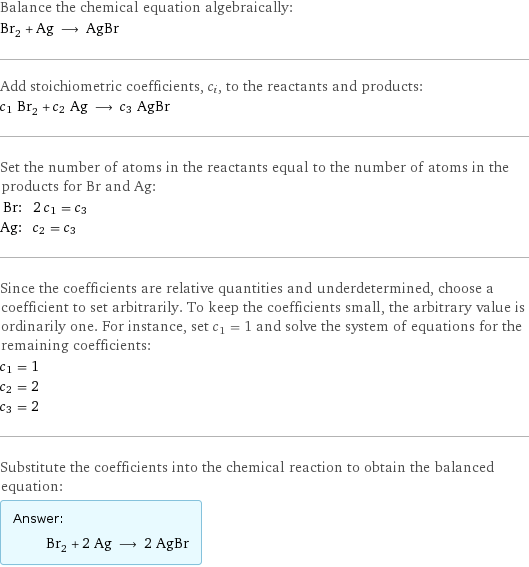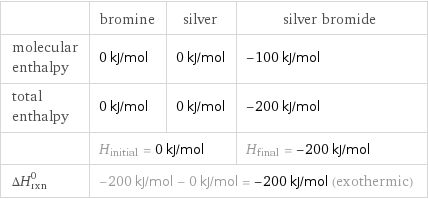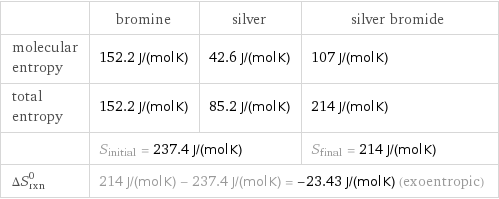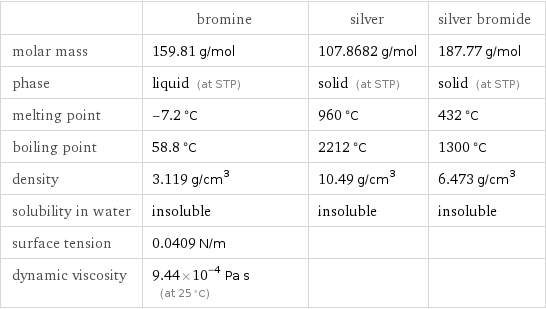Input interpretation

Br_2 bromine + Ag silver ⟶ AgBr silver bromide
Balanced equation

Balance the chemical equation algebraically: Br_2 + Ag ⟶ AgBr Add stoichiometric coefficients, c_i, to the reactants and products: c_1 Br_2 + c_2 Ag ⟶ c_3 AgBr Set the number of atoms in the reactants equal to the number of atoms in the products for Br and Ag: Br: | 2 c_1 = c_3 Ag: | c_2 = c_3 Since the coefficients are relative quantities and underdetermined, choose a coefficient to set arbitrarily. To keep the coefficients small, the arbitrary value is ordinarily one. For instance, set c_1 = 1 and solve the system of equations for the remaining coefficients: c_1 = 1 c_2 = 2 c_3 = 2 Substitute the coefficients into the chemical reaction to obtain the balanced equation: Answer: | | Br_2 + 2 Ag ⟶ 2 AgBr
Structures

+ ⟶
Names

bromine + silver ⟶ silver bromide
Reaction thermodynamics
Enthalpy

| bromine | silver | silver bromide molecular enthalpy | 0 kJ/mol | 0 kJ/mol | -100 kJ/mol total enthalpy | 0 kJ/mol | 0 kJ/mol | -200 kJ/mol | H_initial = 0 kJ/mol | | H_final = -200 kJ/mol ΔH_rxn^0 | -200 kJ/mol - 0 kJ/mol = -200 kJ/mol (exothermic) | |
Entropy

| bromine | silver | silver bromide molecular entropy | 152.2 J/(mol K) | 42.6 J/(mol K) | 107 J/(mol K) total entropy | 152.2 J/(mol K) | 85.2 J/(mol K) | 214 J/(mol K) | S_initial = 237.4 J/(mol K) | | S_final = 214 J/(mol K) ΔS_rxn^0 | 214 J/(mol K) - 237.4 J/(mol K) = -23.43 J/(mol K) (exoentropic) | |
Equilibrium constant
![Construct the equilibrium constant, K, expression for: Br_2 + Ag ⟶ AgBr Plan: • Balance the chemical equation. • Determine the stoichiometric numbers. • Assemble the activity expression for each chemical species. • Use the activity expressions to build the equilibrium constant expression. Write the balanced chemical equation: Br_2 + 2 Ag ⟶ 2 AgBr Assign stoichiometric numbers, ν_i, using the stoichiometric coefficients, c_i, from the balanced chemical equation in the following manner: ν_i = -c_i for reactants and ν_i = c_i for products: chemical species | c_i | ν_i Br_2 | 1 | -1 Ag | 2 | -2 AgBr | 2 | 2 Assemble the activity expressions accounting for the state of matter and ν_i: chemical species | c_i | ν_i | activity expression Br_2 | 1 | -1 | ([Br2])^(-1) Ag | 2 | -2 | ([Ag])^(-2) AgBr | 2 | 2 | ([AgBr])^2 The equilibrium constant symbol in the concentration basis is: K_c Mulitply the activity expressions to arrive at the K_c expression: Answer: | | K_c = ([Br2])^(-1) ([Ag])^(-2) ([AgBr])^2 = ([AgBr])^2/([Br2] ([Ag])^2)](../image_source/c680aade986531e89c083c9e15bc1b1e.png)
Construct the equilibrium constant, K, expression for: Br_2 + Ag ⟶ AgBr Plan: • Balance the chemical equation. • Determine the stoichiometric numbers. • Assemble the activity expression for each chemical species. • Use the activity expressions to build the equilibrium constant expression. Write the balanced chemical equation: Br_2 + 2 Ag ⟶ 2 AgBr Assign stoichiometric numbers, ν_i, using the stoichiometric coefficients, c_i, from the balanced chemical equation in the following manner: ν_i = -c_i for reactants and ν_i = c_i for products: chemical species | c_i | ν_i Br_2 | 1 | -1 Ag | 2 | -2 AgBr | 2 | 2 Assemble the activity expressions accounting for the state of matter and ν_i: chemical species | c_i | ν_i | activity expression Br_2 | 1 | -1 | ([Br2])^(-1) Ag | 2 | -2 | ([Ag])^(-2) AgBr | 2 | 2 | ([AgBr])^2 The equilibrium constant symbol in the concentration basis is: K_c Mulitply the activity expressions to arrive at the K_c expression: Answer: | | K_c = ([Br2])^(-1) ([Ag])^(-2) ([AgBr])^2 = ([AgBr])^2/([Br2] ([Ag])^2)
Rate of reaction
![Construct the rate of reaction expression for: Br_2 + Ag ⟶ AgBr Plan: • Balance the chemical equation. • Determine the stoichiometric numbers. • Assemble the rate term for each chemical species. • Write the rate of reaction expression. Write the balanced chemical equation: Br_2 + 2 Ag ⟶ 2 AgBr Assign stoichiometric numbers, ν_i, using the stoichiometric coefficients, c_i, from the balanced chemical equation in the following manner: ν_i = -c_i for reactants and ν_i = c_i for products: chemical species | c_i | ν_i Br_2 | 1 | -1 Ag | 2 | -2 AgBr | 2 | 2 The rate term for each chemical species, B_i, is 1/ν_i(Δ[B_i])/(Δt) where [B_i] is the amount concentration and t is time: chemical species | c_i | ν_i | rate term Br_2 | 1 | -1 | -(Δ[Br2])/(Δt) Ag | 2 | -2 | -1/2 (Δ[Ag])/(Δt) AgBr | 2 | 2 | 1/2 (Δ[AgBr])/(Δt) (for infinitesimal rate of change, replace Δ with d) Set the rate terms equal to each other to arrive at the rate expression: Answer: | | rate = -(Δ[Br2])/(Δt) = -1/2 (Δ[Ag])/(Δt) = 1/2 (Δ[AgBr])/(Δt) (assuming constant volume and no accumulation of intermediates or side products)](../image_source/8c13935301ceeaf8a61adbb0bd7dcb19.png)
Construct the rate of reaction expression for: Br_2 + Ag ⟶ AgBr Plan: • Balance the chemical equation. • Determine the stoichiometric numbers. • Assemble the rate term for each chemical species. • Write the rate of reaction expression. Write the balanced chemical equation: Br_2 + 2 Ag ⟶ 2 AgBr Assign stoichiometric numbers, ν_i, using the stoichiometric coefficients, c_i, from the balanced chemical equation in the following manner: ν_i = -c_i for reactants and ν_i = c_i for products: chemical species | c_i | ν_i Br_2 | 1 | -1 Ag | 2 | -2 AgBr | 2 | 2 The rate term for each chemical species, B_i, is 1/ν_i(Δ[B_i])/(Δt) where [B_i] is the amount concentration and t is time: chemical species | c_i | ν_i | rate term Br_2 | 1 | -1 | -(Δ[Br2])/(Δt) Ag | 2 | -2 | -1/2 (Δ[Ag])/(Δt) AgBr | 2 | 2 | 1/2 (Δ[AgBr])/(Δt) (for infinitesimal rate of change, replace Δ with d) Set the rate terms equal to each other to arrive at the rate expression: Answer: | | rate = -(Δ[Br2])/(Δt) = -1/2 (Δ[Ag])/(Δt) = 1/2 (Δ[AgBr])/(Δt) (assuming constant volume and no accumulation of intermediates or side products)
Chemical names and formulas

| bromine | silver | silver bromide formula | Br_2 | Ag | AgBr name | bromine | silver | silver bromide IUPAC name | molecular bromine | silver | bromosilver
Substance properties

| bromine | silver | silver bromide molar mass | 159.81 g/mol | 107.8682 g/mol | 187.77 g/mol phase | liquid (at STP) | solid (at STP) | solid (at STP) melting point | -7.2 °C | 960 °C | 432 °C boiling point | 58.8 °C | 2212 °C | 1300 °C density | 3.119 g/cm^3 | 10.49 g/cm^3 | 6.473 g/cm^3 solubility in water | insoluble | insoluble | insoluble surface tension | 0.0409 N/m | | dynamic viscosity | 9.44×10^-4 Pa s (at 25 °C) | |
Units
